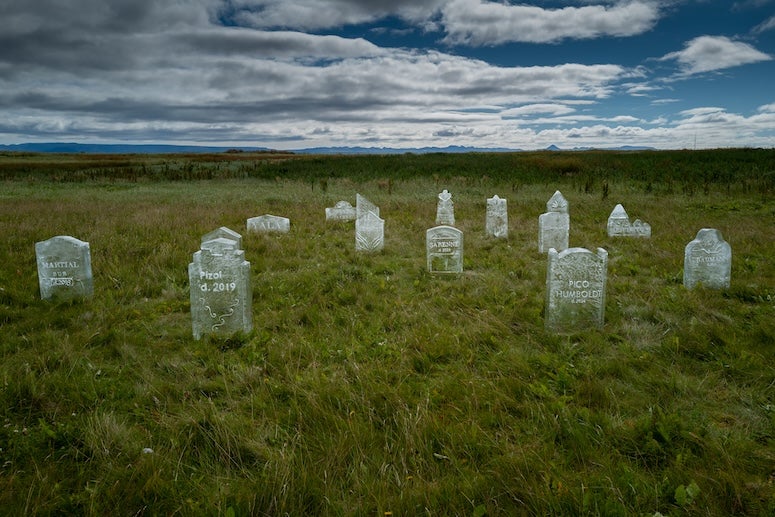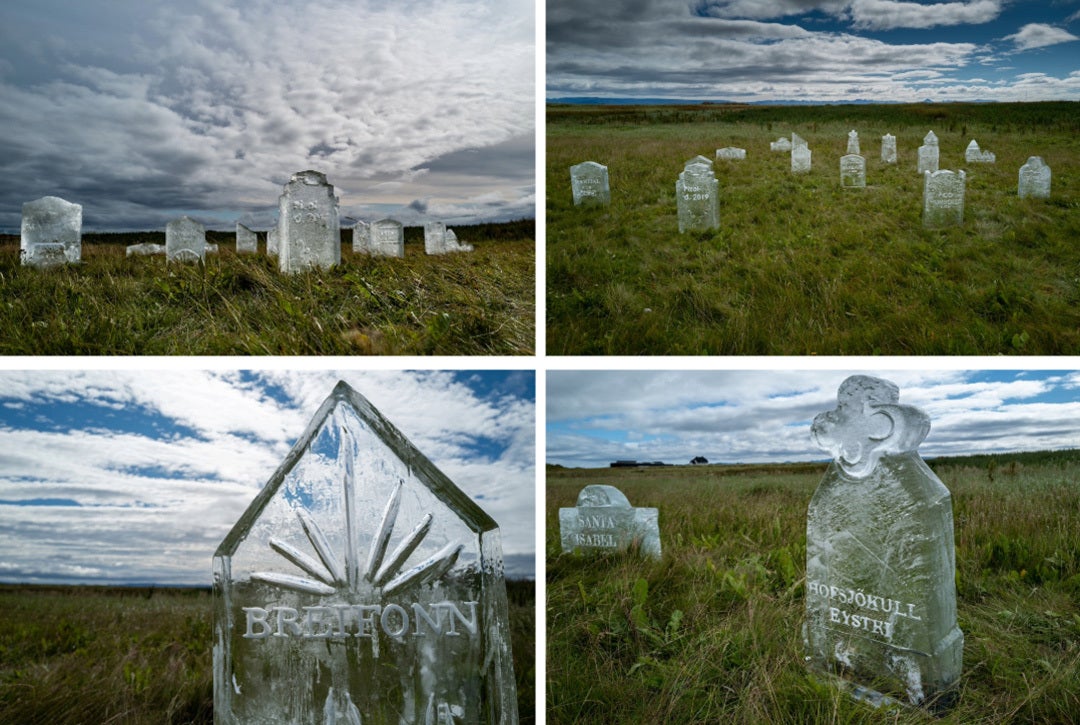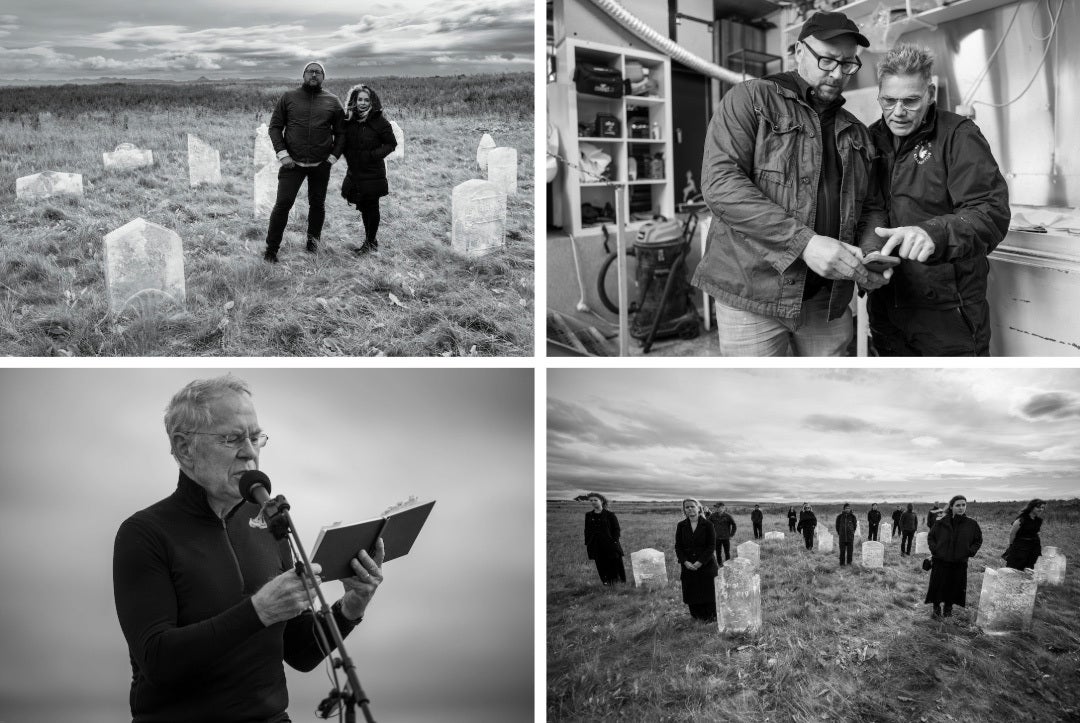Iceland is a land made famous by its glaciers, but these ancient ice forms in the island country and around the world are in danger amid rising global temperatures. Rice University anthropologists Cymene Howe and Dominic Boyer joined with scientists, government officials, climate activists and others to raise awareness with the launch of the world’s first Global Glacier Casualty List and Glacier Graveyard Aug. 17 in Reykavík, Iceland.
The Global Glacier Casualty list was unveiled at Marvaða, a performance venue in Reykjavík. The list is featured on an interactive website and includes 15 extinct and endangered glaciers and stories about them written by individuals from the glaciers’ respective countries.
The event opened with a welcome from Arnbjörg Maria Danielsen, the founder of Marvaða, followed by Boyer, a professor of anthropology at Rice.

“We're no longer losing small patches of glacial ice,” he said. “We're losing glaciers with names and identities with strong connections to personal memory and cultural history. We're losing glaciers that help support the possibility of human life and human flourishing in many different ways.”
Boyer said the platform is focused on glaciers that have vanished in the past 20 years and those expected to expire in the next two decades.
“These are all glaciers wrapped up in our lives,” Boyer said. “They belong to the time that we have together, not abstract future losses, but real losses that you can feel and will feel with all of your senses. We're asking for help from you and from the world in telling these glaciers’ stories.”
Boyer’s remarks were followed by presentations by Icelandic glaciologists Guðfinna Aðalgeirsdôttir and Hrafnhildur Hannesdôttir, who provided general information about glaciers, shared visual examples of glacial melt over the past century and warned of future consequences if steps are not taken to mitigate global warming.
“The story is very clear,” Aðalgeirsdôttir said, noting the more that is done to limit global warming, the more it will limit glacier losses.
Following Aðalgeirsdôttir and Hannesdôttir’s remarks, Patrick Le Menes from the French Embassy in Iceland spoke about international efforts to combat global warming, including t he Paris Agreement and the Paris Call for Glaciers and Poles , announced during the One Planet - Polar Summit during the Paris Peace Forum.
“Let's hope that (these efforts) will mark the beginning for full mobilization by the international community to fight against the melting of ice and the collapse of the cryosphere,” he said.
Howe and Boyer will collaborate with scientists and communities to add more glaciers to the website each year as the ice forms continue to wane and/or expire. Until now, no platform existed to track the losses and tell the stories of how the glacier losses have impacted local communities.
Following the official launch of the Global Glacier Casualty List, approximately 100 individuals hiked to the site of the world’s first Glacier Graveyard on the Seltjarnarnes peninsula near Reykjavík. The graveyard consisted of 15 headstones carved from ice by Icelandic ice sculptor Ottó Magnússon, placed in a lush field next to the sea and bearing the names of glaciers from around the world that are lost or waning due to global warming. A ceremony honoring them and focused on climate action took place, with local participants and international representatives reading eulogies for the lost or declining glaciers. An Icelandic choir performed.
Howe noted that rituals for the dead have always been a part of human societies and said the graveyard serves as a call to action and a way for people to feel the impacts of climate change on an emotional level.
“We have never needed a graveyard for glaciers before,” Howe said. “Now we do. And while these headstones will melt away – like their glacial counterparts – we hope the ceremony and icy gravestones serve as poignant reminders that the world’s glaciers are doomed to the same fate without quick action.”
Howe said the physical act of seeing and feeling the melting ice is an important part of making glaciers more real for those who have never encountered them.
“Because most people on earth will never touch, smell or taste a glacier,” she said. “In this graveyard we bring glaciers close to us, to see that like human beings, they too can die — and sure enough they are dying by our hands.”
Icelandic glaciologist Oddur Sigurðsson, who first declared the Icelandic glacier Okjökull had lost its status, spoke about the glacier Hofsjökull eystri, noting it is a place that reindeer seek out for refuge. The glacier sits atop a high mountain crest to the east of Iceland's most massive glacier, Vatnajökull, in the Icelandic highlands. But like so many other glaciers around the world, it is in danger of losing its status.
“Like its cousin Okjökull to the west, Hofsjökull eystri is facing a crisis: the persistent heat made by humans,” Sigurðsson said. “All this heat means that in just a few decades from now, Hofsjökull eystri will come to an end.”
Other speakers for the event provided touching remarks about the other glaciers on the list including Martial Sur in Argentina, Sarenne in France and Anderson in the United States. All of the eulogies expressed deep regret over the dead or dying glaciers, but also hope that the ones that remain can be saved if action is taken now.
“All of us standing here will one day die,” Howe said during her remarks. “Every person that we know, or have ever known, will also die. That is what it means to be human. That is what it means to be living. But the glaciers of the world do not need to die. They can continue to live, and to thrive, if we, collectively, can choose a better way into the future.”
The events were attended by diplomats from the embassies of countries with recently lost glaciers as well as youth climate activists, political figures, scientists, artists and the general public, and were co-sponsored by Rice, University of Iceland, Icelandic Glaciological Society, World Glacier Monitoring Service, Icelandic Museum of Natural History and UNESCO, which is working to raise awareness of the importance of glaciers to world heritage. These events come just months before 2025, designated as the International Year of Glaciers’ Preservation by the United Nations.
Both the casualty list and graveyard were unveiled almost five years to the day after Howe and Boyer joined together with government leaders, climate activists and other individuals to mourn the loss of Iceland’s first glacier lost to climate change. The event received widespread international media attention and paved the way for other individuals mourning glaciers around the world. The year prior to the glacier memorial, Howe and Boyer premiered “Not Ok,”a documentary about Okjökull, which in 2014 became Iceland’s first named glacier to lose its “glacier” title. Scientists fear all of the island country’s glaciers will be gone by 2200.
Glaciers are the world’s largest sources of freshwater, and when they melt, it has far-reaching implications for ecosystems, economies and societies worldwide. As glaciers melt, they contribute to the rise in global sea levels, posing threats to coastal communities, low-lying areas and island nations, leading to increased risk of flooding, erosion and loss of habitats. In addition, the loss of glaciers impacts water resources and contributes to further global warming.
Howe and Boyer hope their work will help the broader public learn more about the impacts of human-caused climate change on the world’s glaciers and the communities that depend on them.
For more information on any of the events or to interview the participants, contact Amy McCaig, senior media relations specialist at Rice, at 713-348-6777 or amym@rice.edu.
Click here to download associated media files (photos and b-roll)



